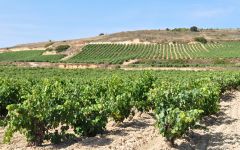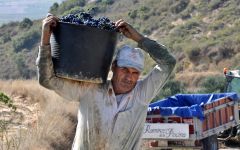Bodegas Ramirez de la Piscina Reserva 2015
-
James
Suckling -
Wilfred
Wong



Product Details
Your Rating
Somm Note
Winemaker Notes
Traditionally styled Rioja Reserva. Balsamic aromatics, complemented by undertones of red berries and earthiness. Notes of licorice and spice emerge on the palate.
Professional Ratings
-
James Suckling
Sweet plum, cigar tobacco and Spanish cedar on the nose. Medium-bodied with fine tannins and a polished, caressing finish. Attractive chocolate and walnut flavors, too. Drink now.
-
Wilfred Wong of Wine.com
COMMENTARY: The 2015 Ramirez de la Piscina drinks nicely and shows a pleasing tang in the aftertaste. TASTING NOTES: This wine serves up aromas and flavors of red fruits, savory spices, and chalkiness. Pair it with pan-seared flap steak topped with chopped white onions. (Tasted: July 21, 2020, San Francisco, CA)
Other Vintages
2018-
James
Suckling
-
Wine
Enthusiast -
James
Suckling
- Decanter
-
Wine
Enthusiast -
Wine &
Spirits -
James
Suckling -
Wilfred
Wong
-
Wine
Enthusiast -
James
Suckling
-
Wine
Spectator -
Wilfred
Wong
-
Robert
Parker








The name Ramírez de la Piscina traces its lineage back to the Navarra Kings who fought in the First Crusade during the 11th century. In early 1945, Julio Ramírez de la Piscina, followed the tradition inherited from his parents in Ábalos, and continued cultivating the family vineyards in San Vicente de la Sonsierra and began producing traditional Rioja wines. In 1961, Julio moved to Bilbao with his wife Angela and began selling his wine in the old Bodeguilla Riojana in the Plaza del Corazón de María.
In 1973, Bodegas Ramírez was officially founded and began to sell bottled wine under this name. In 1980, the fourth generation of the Ramírez de la Piscina family took over management of the winery, and in 1987, the name was changed to Bodegas Ramírez de la Piscina. The name change honors the family's historic surname, which is an ancient aristocratic Medieval Riojan name, originating from a 12th Century Romanesque church nearby the vineyards called Santa María de la Piscina.
All of the vineyards are estate owned and the vast majority of the plantings are Tempranillo on high density trellis. The oldest Tempranillo vineyards are head trained, and the family owns a few small plants of Garnacha, Viura, and Malvasia, that are used for the Rosado and Blanco. Ramirez de la Piscina champions the tradition of ageing classified, traditional styled Rioja.

Hailed as the star red variety in Spain’s most celebrated wine region, Tempranillo from Rioja, or simply labeled, “Rioja,” produces elegant wines with complex notes of red and black fruit, crushed rock, leather, toast and tobacco, whose best examples are fully capable of decades of improvement in the cellar.
Rioja wines are typically a blend of fruit from its three sub-regions: Rioja Alta, Rioja Alavesa and Rioja Oriental, although specific sub-region (zonas), village (municipios) and vineyard (viñedo singular) wines can now be labeled. Rioja Alta and Alavesa, at the highest elevations, are considered to be the source of the brightest, most elegant fruit, while grapes from the warmer and drier, Rioja Oriental, produce wines with deep color, great body and richness.
